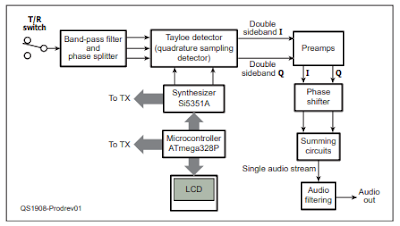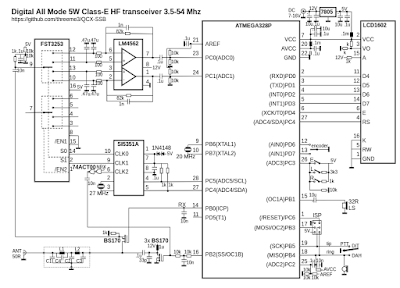Hack-A-Day carried a very nice video describing recent efforts to turn Hans Summers' amazing QCX CW monoband transceiver into a multi-mode, multi-mode (including SSB) rig (see above). This is project will greatly interest QCX and SDR fans.
But I wondered how much of the old QCX is still there after the modification. Not much, it turns out.
Here is the bloc diagram of the QCX. It is essentially a phasing rig, using the same principles as my venerable HT-37 transmitter and my version of KK7B's R2 receiver:
Yesterday Paul VK3HN sent me the schematic of the new multi-mode, multi-band version:
Notice how different it is. I thought that perhaps the new rig would keep something of the I-Q circuitry of the QCX, but it does not. This is not a criticism, just an observation.
But here is something that harks back to a topic we've been debating on the blog and podcast. Notice that the top diagram is a bloc diagram. There is a lot of circuitry in most of those boxes -- lots of resistors, capacitors, inductors, and transistors. There is a schematic diagram under that bloc diagram. But look at the second diagram. While it looks like one, that one is NOT a bloc diagram. That IS the schematic diagram. Most of the circuity has been sucked into the chips.
While many will prefer the rig described by the second diagram, I remain an HDR guy, and don't really like seeing the circuitry disappear into the ICs. But, to each his own. This is all for fun. Congratulations to the guys working on the new rig.


























Except one is a schematic, and the other a block diagram, I don't see much difference.
ReplyDeleteBoth have an oscillator putting out a quadrature signal, actually the same IC is used. Both have dualTayloe mixers, providing I-Q signal.
The immediate difference is that maybe the original uses an RC audio phase network (it's not obvious from the block diagram) while the new does the phase shifting in the digital realm.
You have to grasp concepts first.
Phasing transmitters and receivers have used all kinds of mixers, diode, triode, 7360s, DBMs, 1496s even NE602s. That doesn't change the concept.
RF phasing networks were generally LC networks,until flip-flops came along and got fast enough. Like 1974. Or kind of a variant of the 3rd Method, feed tge VFO into two mixers, the other inputs fed with quadrature signal.
Here, the quadrature signal is generated directly.
In the early days of SSB, the audio phasing network was primitive. A few resistors and capacitors. The B&W 2Q4 was primitive, just better tolerance components. Limited bandwidth and acceptance of less opposite sideband suppression allowed for cheaper and simpler networks.
Dome and polyphase networks were around about 1974, though few were building phasing rigs. More comoonents and sometimes active circuits, but certainoy the polyphase network required fewer values.
If you could start with a quadrature audio signal, it would be so much easier. But tgat can't happen. Though, for CW you could use a quadrature sine wave oscillator (like a tri-state filter with feedback), the two outputs woukd always be 90 degrees apart, and you'd get CW output from the ohasing rig.
In the seventies there was some ideas abiut using audio delay lines for audio phasing, but soon the shift was to digital.
Using a DSP is just a step forward. It's the same concept. Convert to digital.and then do the phase shifting in digital. Simpler overall, and you get more precise phase shift. If tge ICs are cheap, it's cheaper than a bunch of precision resistors and capacitors.
Michael: You know what I mean. Those ICs contain more and more of the circuitry. Sure, the modified QCX has I and Q circuitry in there, but it doesn't really have to have this circuity, right? They could have gone Direct Digital Sampling with a fast ADC and that would be that, correct? And for me, the way in which the digi schematic starts to look like a block diagram says something. I do know the difference between a block diagram and a schematic.
ReplyDeleteFor the audio phase shift, I use KK7B's op amps in my phasing receiver. They work well, and I get good sideband rejection. Your message seems to imply that this is harder to do with transmitters unless the phase shift is done digitally. But why would this be so? Is it just because it is harder to get consistent 90 degree phase shift across the full 300 -- 3000 Hz audio range? 73 Bill